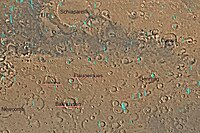Flaugergues (crater)

Quadrangle map of Sinus Sabaeus labeled with major features. Colored rectangles represent image footprints of Mars Global Surveyor.
|
|
| Planet | Mars |
|---|---|
| Coordinates | 17°00′S 340°48′W / 17°S 340.8°WCoordinates: 17°00′S 340°48′W / 17°S 340.8°W |
| Diameter | 245 km |
| Eponym | Honore Flaugergues, a French astronomer (1755-1835) |
Flaugergues is a crater in the Sinus Sabaeus quadrangle on Mars at 17° south latitude and 340.8° west longitude. It is about 245 km in diameter. It was named after Honore Flaugergues, a French astronomer (1755-1835).
Impact craters generally have a rim with ejecta around them, in contrast volcanic craters usually do not have a rim or ejecta deposits. As craters get larger (greater than 10 km in diameter) they usually have a central peak. The peak is caused by a rebound of the crater floor following the impact. If one measures the diameter of a crater, the original depth can be estimated with various ratios. Because of this relationship, researchers have found that many Martian craters contain a great deal of material; much of it is believed to be ice deposited when the climate was different. Sometimes craters expose layers that were buried. Rocks from deep underground are tossed onto the surface. Hence, craters can show us what lies deep under the surface.
The density of impact craters is used to determine the surface ages of Mars and other solar system bodies. The older the surface, the more craters present. Crater shapes can reveal the presence of ground ice.
The area around craters may be rich in minerals. On Mars, heat from the impact melts ice in the ground. Water from the melting ice dissolves minerals, and then deposits them in cracks or faults that were produced with the impact. This process, called hydrothermal alteration, is a major way in which ore deposits are produced. The area around Martian craters may be rich in useful ores for the future colonization of Mars. Studies on the earth have documented that cracks are produced and that secondary minerals veins are deposited in the cracks. Images from satellites orbiting Mars have detected cracks near impact craters. Great amounts of heat are produced during impacts. The area around a large impact may take hundreds of thousands of years to cool. Many craters once contained lakes. Because some crater floors show deltas, we know that water had to be present for some time. Dozens of deltas have been spotted on Mars. Deltas form when sediment is washed in from a stream entering a quiet body of water. It takes a bit of time to form a delta, so the presence of a delta is exciting; it means water was there for a time, maybe for many years. Primitive organisms may have developed in such lakes; hence, some craters may be prime targets for the search for evidence of life on the Red Planet.
Small crater on the rim of Flaugergues with material flowing into it, as seen by HiRISE.
Part of floor and eroded south wall of Flaugergues, as seen by CTX camera (on Mars Reconnaissance Orbiter). Arrows point to wrinkle ridges. Channels are visible in wall.
...
Wikipedia
